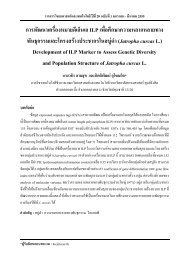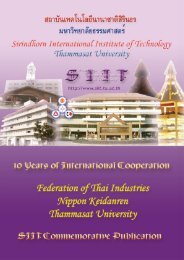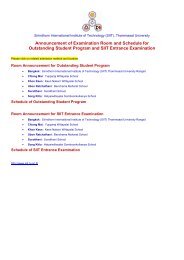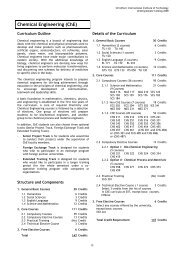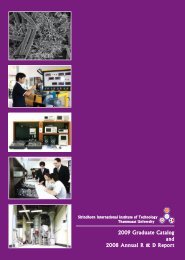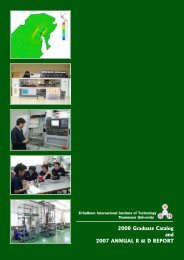2007 Graduate Catalog and 2006 Annual R & D Report - Sirindhorn ...
2007 Graduate Catalog and 2006 Annual R & D Report - Sirindhorn ...
2007 Graduate Catalog and 2006 Annual R & D Report - Sirindhorn ...
Create successful ePaper yourself
Turn your PDF publications into a flip-book with our unique Google optimized e-Paper software.
<strong>2007</strong> <strong>Graduate</strong> <strong>Catalog</strong> <strong>and</strong> <strong>2006</strong> <strong>Annual</strong> R & D <strong>Report</strong><br />
<strong>Sirindhorn</strong> International Institute of Technology (SIIT)<br />
Dr. Suebsak Nanthavanij<br />
Associate Professor<br />
B.S. in Chemical Engineering, Chulalongkorn University, Thail<strong>and</strong><br />
M.S. & Ph.D. in Industrial Engineering, University of Texas at Arlington, USA<br />
Areas of Specialization: Industrial ergonomics, Workforce scheduling, Industrial noise.<br />
Research Interests:<br />
Performance Analysis of Ergonomics-based<br />
Manual Assembly Line with Parallel Workstations<br />
<strong>and</strong> Floaters<br />
It has been long known that manual assembly tasks<br />
are repetitive <strong>and</strong> require the use of specific muscles<br />
in the upper extremities, creating excessive postural<br />
<strong>and</strong> physical loads on the excessively used body<br />
members. As a result, manual assembly line workers<br />
are at high risk of cumulative trauma disorders in the<br />
upper extremities. When ergonomics concerns are<br />
introduced to the manual assembly line balancing<br />
problems to assign assembly tasks to workers to<br />
achieve the maximum postural-physical loads<br />
smoothness, the resulting task-workstation<br />
assignment solution must be determined using an<br />
ergonomics-based approach. Unfortunately, the line<br />
throughput is likely to decrease since the balance<br />
delay of the line might be compromised. This<br />
research project is intended to investigate the effect<br />
of adding parallel workstations to some potential<br />
bottleneck workstations <strong>and</strong> providing floaters (or<br />
extra helpers) to those parallel workstations so as to<br />
increase the assembly line productivity. Additionally,<br />
several strategies for opening parallel workstations<br />
<strong>and</strong> rotating floaters among them will be investigated<br />
with respect to various desired throughput rates. The<br />
Rapid Upper Limb Assessment (RULA) technique will<br />
be used to assess the postural <strong>and</strong> physical loads<br />
imposed on the musculoskeletal system of the body<br />
when performing each manual assembly task. A<br />
heuristic procedure will be employed to assign<br />
assembly tasks to workstations using a mixed<br />
productivity <strong>and</strong> ergonomics consideration. Based on<br />
predefined dispatching strategies to assign floaters<br />
<strong>and</strong> rotate them among parallel workstations,<br />
simulation models will be developed. The<br />
performance of the given manual assembly line under<br />
different throughput rate requirements <strong>and</strong><br />
operational conditions will be analyzed. The variables<br />
of interest include: throughput rate, number of fulltime<br />
workstations, number of parallel workstations,<br />
number of floaters, dispatching strategy, <strong>and</strong><br />
switchover strategy. The performance indices are:<br />
achieved throughput rate, balance delay, utilization<br />
rates of full-time <strong>and</strong> parallel workstations, switchover<br />
rates, <strong>and</strong> average queue lengths at full-time<br />
workstations.<br />
Ergonomics-based Workforce Scheduling for the<br />
Vehicle Routing Problem<br />
The vehicle routing problem is intended to determine<br />
the optimal number of vehicles to delivery goods<br />
between finite sets of origins <strong>and</strong> destinations, <strong>and</strong><br />
their delivery routes. There are numerous variants of<br />
the vehicle scheduling problem that have been<br />
studied by operations research <strong>and</strong> industrial<br />
engineering researchers. However, very few (if any)<br />
have paid attention to the vehicle drivers. In realworld<br />
situations, vehicle drivers might not only drive<br />
delivery vehicles but also perform loading <strong>and</strong><br />
unloading of goods at both the origins <strong>and</strong><br />
destinations. With limited time windows,<br />
loading/unloading operations may require more than<br />
one person to perform. Moreover, long-distance<br />
driving is stressful <strong>and</strong> increases the risk of highway<br />
accidents. Alternate drivers may be required for<br />
certain delivery routes. This research project is<br />
intended to take the loading/unloading workload <strong>and</strong><br />
long-distance driving into consideration when finding<br />
the optimal workforce schedule for the vehicle routing<br />
problem. Based on the given delivery loads (in terms<br />
of required energy costs) <strong>and</strong> the driving distances for<br />
individual delivery trucks, a heuristic approach will be<br />
developed to determine the minimum numbers of<br />
vehicles <strong>and</strong> operators (drivers <strong>and</strong> movers) <strong>and</strong> their<br />
delivery routes so as to minimize the total traveling<br />
distance without exceeding the recommended daily<br />
energy expenditure <strong>and</strong> driving distance.<br />
Workforce Scheduler: An Ergonomic Manpower<br />
Management Tool<br />
This research project is intended to develop a<br />
computerized tool called Workforce Scheduler for<br />
ergonomically managing manpower for a hazardous<br />
work system. A group of industrial workers will<br />
receive daily work assignments to operate/attend a<br />
set of machines/workstations in the workplace where<br />
ergonomics, safety, <strong>and</strong> health hazards are present.<br />
Job rotation will be implemented to alleviate the<br />
workers’ hazard exposures. The types of hazard<br />
considered in Workforce Scheduler include industrial<br />
noise, heat, over-exhaustion, over-exertion, <strong>and</strong> toxic<br />
gases. Workers may be considered as identical or<br />
non-identical receivers, depending on the type of<br />
hazard <strong>and</strong> body tolerance. Workforce Scheduler<br />
allows the user to choose between the single-hazard<br />
exposure option <strong>and</strong> the two-hazard exposure option.<br />
The permissible daily exposure level must be<br />
specified prior to the workforce scheduling.<br />
Workforce Scheduler will determine the daily work<br />
assignment for each worker such that his/her hazard<br />
exposure does not exceed the permissible level.<br />
Additionally, the weekly work schedule for the worker<br />
can be set so that his/her daily hazard exposures for<br />
different workdays will not be the same.<br />
31




